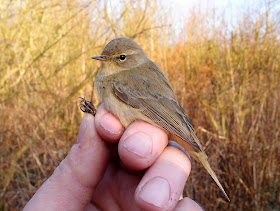I have only ringed one Chiffchaff since my last post and they are still fairly thin on the ground or absent from my sites. A wintering male Blackcap is still visiting the feeders in the garden each day and I am almost certain it is the bird that was ringed there on 10th January. A second male also makes an occasional appearance and I suspect this is the other male I ringed in January rather than a newly arrived spring migrant.
 |
| Chiffchaff ringed 25/03/15 |
 |
| The privet hedge has a lot of ivy growing through it and the bird has picked a location where a lot of debris from cuttings builds up in the hedge. |
 |
| ..........and a closer view from the same angle. |

















